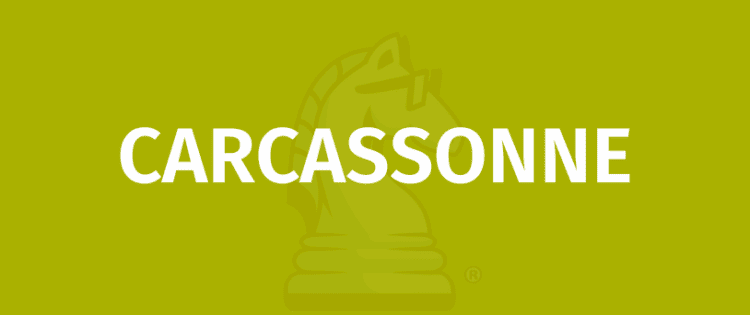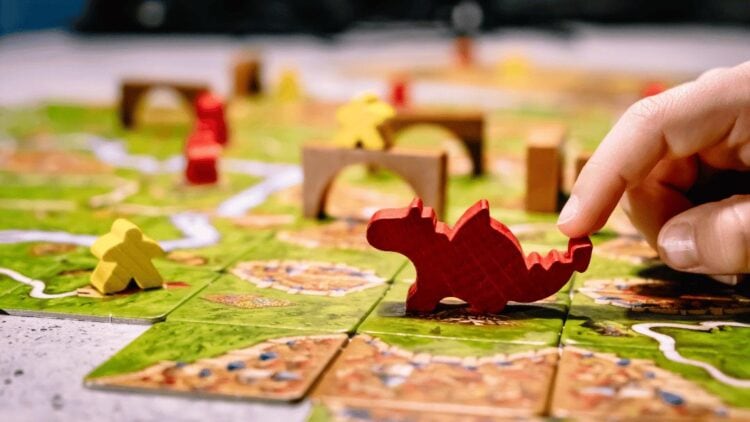
OBJECTIVE OF CARCASSONNE: Have the highest score at the end of the game.
NUMBER OF PLAYERS: 2-5 players
MATERIALS OF CARCASSONNE: 72 land tiles, 40 followers, 1 score tracker
TYPE OF GAME: Tile-laying board game
AUDIENCE: 10 years & up
OVERVIEW OF CARCASSONNE
- INTRODUCTION TO STRATEGY: Experience the timeless allure of "Carcassonne," a...
- SIMPLE YET ENGAGING: With intuitive rules—place tiles, deploy meeples, score...
- BEAUTIFUL ILLUSTRATIONS: Immerse yourself in the game's enchanting world through...
Carcassonne is a German-style board game that utilizes tile laying. Similar to Flipover Frog but much more advanced. It was designed by Klaus-Jürgen Wrede and published in 2000 by the German game company Hans im Glück and later by Rio Grande Games in 2012.
The game is named after the medieval town Carcassonne, located in southern France, known for its fortifying city walls. The game has numerous expansions and spin-offs, but in this post, we’re going to go over all the rules and strategies you need to know for the basic version of Carcassone.
SET UP FOR CARCASSONNE

Carcassonne is an extremely fun game that you can play with up to five players. It’s a game you have to try with friends and family. At the beginning it can seem a bit daunting, but once you get the basics down, the gameplay is quite simple. All you need is a Carcassonne game, a few friends, and a flat surface to play on.
WHAT’S IN THE BOX
As soon as you unbox Carcassonne, you’ll notice that it is a pretty complicated board game with lots of pieces. The newest editions come with:
- 1 Start Tile.
- 71 Land Tiles.
- 40 Followers (8 × 5 Colors)
- 1 Scoring Track.
- 1 Rule Booklet.
- The River Mini-Expansion: 12 River Tiles.
- The Abbot Mini-Expansion: 6 Abbots.
The river pieces and abbots are expansions, so you don’t need to worry about those for the base game. You will use the 72 land tiles: one starting tile (black tile) and tiles that depict roads, fields, cities, and cloisters.
There are also 40 pieces or followers in the box in five colors. You can designate these pieces as a thief, monk, farmer, or knight (explained below). One of your pieces is for keeping score. The game also includes a scoring track. The scoring track is a small tile with numbers one through 49, and you move your piece whenever you score to keep track.
THE PRE-GAME
Start by placing the starting tile face up in the center of the table. Then, shuffle the remaining tiles thoroughly. Place them in multiple face-down stacks for easy accessibility. Put the score track near any edge of the table.
Each player should take eight pieces of their color and place one on the score tracker on the starting score of zero. Leave the seven remaining pieces in front of you until the game starts.
The youngest player gets to pick who will play first.
HOW TO PLAY CARCASSONNE
Now, the setup is done, and you’re ready to begin. Take alternating turns, starting with one player and moving to the left. During a turn, you must do the following in order:
- Draw and lay new tiles,
- Release a follower on that tile,
- Score possible roads, cities, and cloisters that are completed.
Laying Tiles

Draw a tile from one of the face-down stacks. Examine it and show it to other players (other players may advise on ‘proper’ placement), and lay it on the table. Follow the rules below for laying tiles:
- You must place new tiles so that one edge of the tiles aligns with and/or matches the edge of the old tile next to it.
- You can not place tiles next to each other willy-nilly, you should place them together in logical consequence.
- Roads must match with roads, fields with fields, etc.
If you can’t place a tile because it doesn’t align with any tiles on the table, while this is rare, discard the tile and draw a new one.
Deploying Pieces
Once you place a tile, you can place one of your pieces on that tile. The following rules apply.
- Players can deploy only one of their pieces in a turn
- Players can use only their color pieces, no one else’s.
- The piece must be placed on a new tile.
- Players must decide which follower to use and where to place it. Use the images below as a guideline.
You cannot place pieces on features of tiles that are connected with a tile that already has a piece on it. It does not matter who the owner of said piece is. For example, if one player’s piece is on a road section of a tile, you cannot place your piece on the road section of its connecting tile (since it is one continuous road). However, you can place the piece in the field of the connecting piece.
After you have placed all your pieces, continue taking turns and placing tiles. After you score on cities, roads, and cloisters you get your pieces back.
SCORING
This is the final phase of your turn, and when you can count up the points you made with your pieces. You only count the scores of landscape features you have completed. Each landscape feature has different values.
ROADS
A road is completed once it connects at both ends to a city, cloister, or itself (in a loop). A player who has a thief on a finished road scores one point per tile, which contributes to the road.
CITIES
A city is finished once it is surrounded entirely by walls and there are no gaps. Players with knights placed on completed cities earn two points per tile contributing to the city. Tiles with shields on them earn a bonus of two points. However, if a city is made of only two tiles, it earns only two points (not four).
It may occur that a finished road or city has more than one piece on it (from different players). Using clever placement, players may create this unlikely situation. If this happens, the player with the most thieves (on roads) or knights (in cities) takes all the points. If they tie, they both score the full points.
CLOISTER
Cloisters are finished once they have tiles surrounding them on all four sides. Cloisters are depicted on a single tile. A player with a monk on a completed cloister takes nine points. This is one of the best features in Carcassonne.
FARMS
Fields that are connected and enclosed are farms. They are not scored during the game but after it has ended. This is because your field can keep growing throughout the game. Only farmers may be placed on farms and you place them lying down.
Farmers remain on the table until the game is completed. They are scored at the end. We will discuss the farm points in the “Final Scores” section.
RETURNING PIECES
Once you’ve scored with a road, city, or cloister, then you can take the pieces on those tiles back. You can re-use these later in the game as a thief, knight, monk, and farmer.
FINAL SCORES
Once you place the last tile, the Carcassonne game is over. Now, you can add up the final scores.
Add the scores for incomplete cities, roads, and cloisters.
For each incomplete feature, which a player has a piece on, they score one point per tile in the unfinished road or city. Shields earn one point each. An incomplete cloister with a monk earns one point per tile around the cloister tile and one point for the cloister tile.
FARMERS
Farmers earn points if they touch a completed city. You call this “supplying the city. For every complete city a farmer touches or supplies, the player who owns the farmer earns 3 points per city, no matter the size of the city or farm.
END OF GAME
The winner is the player with the highest score at the end of the game.
CARCASSONNE STRATEGY

As you’ve seen, the game is quite simple to play. However, it does involve quite a bit of strategy. Let’s go over some of the best strategies you can use to improve your score!
THERE IS NO LUCK
The first thing you have to understand is that there is almost no luck involved in Carcassonne. Many players think that others get lucky by drawing a better tile, and that is just not true. Every single tile in the game is useful if you know how to use it correctly.
SABOTAGE
This is a very good strategy for Carcassonne. You only need to score higher than your opponents, so what better way than by sabotaging them and stopping them from scoring more points? For example, if you see your opponent about to finish a city with one tile, add a tile that expands their city walls. This makes it much more difficult for them to complete their city.
Or perhaps you see they want to close off their city, maybe you add a road just next to it, so now they need a tile with a city wall plus a road to make a legal placement. This is such a great strategy, and it really gets under your opponent’s skin!
LET OTHERS DO THE WORK
Ok, this isn’t just a single strategy but an overall tactic that involves several different strategies that allow other players to score points for you. One way to do this is to strategically place your tile and your piece inside an opponent’s city. They have spent the whole game building a large city, and you can simply place your tile just next to it so that when they complete it, you will earn points for it, too.
Another way to do this is with the cloisters. Place a cloister next to an opponent’s large city, and they will need to finish building their city, which will inevitably finish your cloister. Yay for free points!
PIECE MANAGEMENT
Remember that your pieces are the ones that score points, not the tiles. Piece management is extremely important. Your pieces stay on the board until a feature is complete. You want to make sure you play enough pieces on the board to score points, but also keep a piece or two in reserve in case you are able to successfully complete a feature.
There is nothing worse than having no pieces left and you get the chance to complete a feature. Remember to keep a good balance of pieces on and off the board.
PRACTICE
We may sound like a broken record with this one, but it is really the best one. Practice! The only way to get better at the game is to play and practice. You will start to get better each time, and you will see which strategies work best for you. Remember that each game will be different, and so will your opponent’s strategies. So try to keep a few tricks up your sleeve to maximize your chances of success.
CARCASSONNE VS CATAN
Surely, if you love tile-laying games, then you’ve also heard of Catan. It’s a game somewhat similar to Carcassonne. They both have a medieval theme. They also both involve the strategic laying of tiles to get better resources and score the most points. These are almost the only similarities between the games; let’s discuss how they differ.
TILES

One of the biggest differences between the two games is the tile shape. Carcassonne uses square tiles, while Catan uses hexagon-shaped tiles. This allows for more ways to connect tiles in Catan.
BOARD SETUP
In Carcassonne, the only tile that is setup before the game is the center tile. You set up the board during the game in a random order. In Catan, you set up the board randomly as well, but you setup the whole board before the game starts. Players then take turns building roads and settlements based on the preexisting landscape.
SCORING
Another main difference is in the scoring. In Carcassonne, you score throughout the game by completing landscape features and earning points on the pieces you place. In Catan, you have to place roads and settlements based on the landscape. This then lets you collect resources and build buildings. You score points based on your settlements, cities, development cards, and how large your army is.
You play Catan to 10 points while Carcassonne, the player with the highest score, wins.
These two games are somewhat similar, but you can see that Catan is a bit more involved and much more time-consuming. This doesn’t necessarily mean it’s a better game. There is just a bit more to it than Carcassonne. If you want a shorter version of Catan, you can always play Struggle for Catan.
- FAST-PACED KINGDOM BUILDING: Dive into the world of Catan with the Struggle for...
- STRATEGIC RESOURCE MANAGEMENT: Collect resources, construct roads, settlements,...
- EXPAND YOUR CITIES: Earn victory points by expanding your cities and unlocking...
FINAL THOUGHTS
Carcassone is a fantastic game to play with your whole family on your next game night. It is simple to learn, and there is so much strategy involved once you get the hang of it. The best part is that there are so many expansions to the game that you will never get tired of it! Looking to add a little magic to your game nights? Check out our best Harry Potter board games.
FAQ
How Long Is a Game of Carcassonne?
An average game of Carcassonne can last anywhere from 30 to 90 minutes. It can take longer based on skill level or if using expansions.
Is Carcassonne a Game of Skill or Luck?
Carcassonne is not a game of luck. Every tile in the game is useful, so it is definitely a game of skill.
Is Carcassone Hard to Play?
No, Carcassonne is not hard to play. Learning the gameplay is quite easy, and coming up with strategy just takes practice.
- 20+ Epic Outdoor Drinking Games - June 28, 2024
- 30 Gifts for Board Game Lovers - June 27, 2024
- 33 Games for Church Youth Group - June 21, 2024

